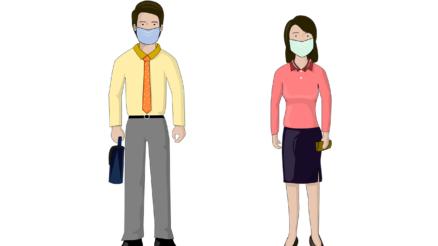There are many types of workplace hazards that can affect employees’ safety and productivity.
According to the National Institute for Occupational Safety and Health (NIOSH), there are more than 4,000 fatal work injuries in the United States each year.
While some of these accidents may be unavoidable, many can be prevented by being aware of the most common hazards and taking precautions.
In this blog post, we will discuss some of the most common workplace hazards and how to protect workplace from them.
What is Workplace Hazard?
‘’A hazard is anything that may cause harm, such as chemicals, electricity, working from heights and heavy equipment.’’
A workplace hazard is any hazard that exists in a workplace. Workplace hazard is any source of potential damage, harm health effects on employees and can also affect the property or equipment of an organization.
It can be anything from a slippery floor to a piece of equipment that is not properly maintained.
Some hazards are more common than others, and some are more dangerous than others. The most important thing to remember is that any hazard, no matter how small, has the potential to cause harm.
Types of Workplace Hazard
There are many potential hazards in the workplace. Here we will discuss some of the most common workplace hazards.
1. Chemical Hazards
Chemical hazards are present either in liquid or gas form. Liquids like paints, acids, solvents and if these products are not labeled properly, it can be very harmful.
Similarly, few chemical hazards are present in the form of gases like acetylene, propane, carbon monoxide, helium and h2s gas.
The exposure of these chemical hazards can cause health problems including breathing problem, cancer and organ failure to death.
2. Physical hazards
Physical hazards are hazards that can cause physical injuries, such as slips, trips and falls. For example, a slippery floor could cause someone to trip and fall, while a poorly maintained piece of equipment could cause an employee to cut or burn themselves.
Another example of a physical hazard is noise. Lot of foot traffic, such as hallways, parking lots and stairwells. Exposure to loud noise can cause hearing loss.
3. Biological Hazards
Biological hazards are living organisms that can cause harm, such as bacteria, viruses and fungi. These hazards can cause a variety of illnesses, ranging from the flu to more serious diseases such as HIV/AIDS and hepatitis.
Biological hazards can also be found in animal waste and bird droppings. These substances can contain harmful bacteria that can cause illness if they come into contact with your skin or are inhaled.
4. Ergonomic Hazards
Ergonomic hazards are hazards that can cause musculoskeletal disorders, such as carpal tunnel syndrome and tendonitis. These conditions can be caused by repetitive motions, awkward positions, poor postures, excessive vibration, abrupt use of too much force.
It’s very hard to notice these conditions because there are no immediate effects of these conditions on human body. In short term result employees may experience little effects such as sore muscles but these can produce serious harmful effects in the long term.
5. Psychosocial Hazards
Psychosocial hazards are hazards that can cause psychological or emotional harm. For example, workplace harassment, bullying at work and stress.
Exposure to psychosocial hazards can lead to a variety of health problems, such as anxiety, depression and sleep disorders.
6. Vehicle-Related Hazards
Vehicle-related hazards are hazards that can be found in any work environment where vehicles are present, such as warehouses, parking lots and construction sites.
These hazards include being struck by a vehicle, being caught between two vehicles and falling from a vehicle.
7. Fire and Explosion Hazards
Fire and explosion hazards are found in workplaces where flammable materials are present, such as manufacturing plants and gas stations.
These hazards can cause serious injuries, including burns respiratory problems and in extreme cases there can loss the life.
US Bureau of Statistics states that nearly 200 workers die every year from fires and explosion occurred at workplace.
8. Electrical Hazards
Electrical hazards are very common at workplaces. According to the Electrical Safety Foundation International, electrical hazards cause more than 300 deaths and around 4,000 injuries in workplaces every year in US.
Electrical hazards are usually found in workplaces where large electrical equipment is present.
These hazards are caused by high electrical voltage and unprotected wires.
When body contact with electricity the current run through the body and can lead to heart and respiratory failures. This hazard is called electrical shocks.
Broken circuits and bare wires when contact with flammable material this can lead to electrical burns in the workplace.
9. Violence in the Workplace
Violence in the workplace is a growing concern in today’s society. This type of hazard can include everything from conflict at workplace to verbal abuse to physical assaults.
Employees may suffer harassment due to their social status, gender or by physical appearance. The harasser may be your coworker employer, even your boss or maybe a client. This leads to conflict and in some case violence.
How to Prevent Workplace Hazards?
Accidents can happen anywhere, but there are simple steps that can be taken to prevent hazard in the workplace.
Training of Workplace Safety
The first step to ensure safety and prevention of workplace hazards is to build capacity of employees on workplace safety. There are many training programs available through which employees get the basic understanding of occupational health and workplace safety and knowledge of best practices and guidelines.
Investing in such a training program will not only build knowledge of employees but also improve their morale and productivity.
Use of Personal Protective Equipment
Personal Protective Equipment reduce the risk of injuries which are caused by accidents at workplace. Every workplace should make it mandatory for all his employees to wear proper Personal Protective Equipment (PPE).
PPEs include earplugs, hard hats, helmet, safety goggles, gloves, air-purifying respirators and safety shoes.
Measures to prevent fire
Fire is a big issue in the workplace area. Every workplace must place fire extinguishers throughout the building. Smoking should not allow in the workplace area because it is a big cause of fire.
If there is any highly flammable material present in workplace then it should be handled with extra care. Similarly, electrical equipment which is not in use should be properly switched off.
Disposing chemical material
Chemical disposing is a great challenge in the workplace. Workplace can be safe by reducing the chemical hazards.
Make sure that containers and equipment that contain chemicals are properly stored and not leaked. Labelling of hazardous material and using of signboards should be inform employees about the potential hazard of chemical material
Prevention against biological hazards
It’s important to practices good hygiene to protect the workplace from biological hazards. Washing hands often and avoiding contact with sick people is one of good those practices which give protection against biological hazards.
Animal waste and birds’ drippings should also be avoided in the workplace.
Practise good ergonomics
There are many practices which gives protection against ergonomic hazards. These include maintaining a good posture, providing lifting and carrying facilities for equipment, alternating tasks and by adjusting computer screen and sitting positions.
Muscle stretching and short breaks can reduce the ergonomic hazards in the workplace.
Taking steps to prevent slips, trips and falls
Accidents will happen, but there are simple steps that can be taken to ensure employees’ safety. Slipping and tripping happens when there is unexpected change in contact between feet and walking surface.
Falling can be avoided by maintaining good housekeeping, neat walking surface and proper footwear.
Conclusion
There are many types of workplace hazard which may cause harm to employees’ health and wellbeing. Every employer should invest in identifying potential hazards at workplace and then certain preventive measures should be taken to reduce these hazards at workplace.



